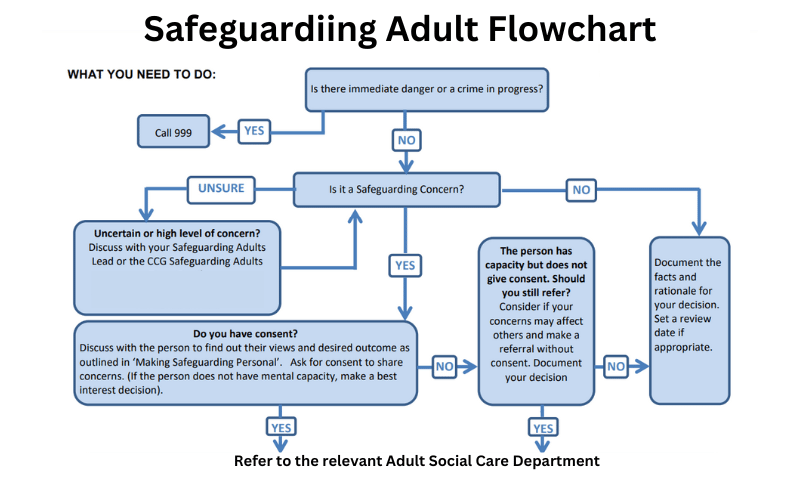

What is a safeguarding flowchart, and why do we need it? As responsible adults, it is our responsibility to keep people around us safe, especially if someone works with children or vulnerable adults. That means we have to be aware of, understand our duties and report any potential safeguarding concerns. Also, we have to know the right reporting procedure and the route to follow in case you have a concern. That is where a safeguarding flowchart comes in.
What is a Safeguarding Flowchart?
A safeguarding flowchart is a diagram or chart. In other words, it visually outlines the steps. It protects individuals from harm, abuse or neglect. Many organisation uses it as a tool to promote best practices in safeguarding.
The flowchart outlines the steps to be taken when a safeguarding concern arises. For example, reporting the concern to the appropriate person or authority. And it also helps to provide support and protection to the individual at risk.
What is the Use Case of the Safeguarding Flowchart?
The use case of a safeguarding flowchart provides clear and concise guidance. This also helps in responding to and managing safeguarding concerns. The flowchart outlines the steps to be taken when a safeguarding concern arises. Also, it helps ensure that all staff know the responsibilities they need to follow.
In addition, the flowchart helps promote best practices in safeguarding. You can also use it to support training and awareness-raising activities. Moreover, it can be used as a reference for staff to respond to safeguarding concerns. Finally, it helps to ensure the right steps are taken to protect vulnerable individuals.
By completing the Level 2 Safeguarding Children Course, learners will know how to
- understand child safeguarding laws, policies, and procedures.
- identify child abuse and neglect
- assess if a child is at risk
- report safeguarding concerns
- know record-keeping guidelines
- and communicate with social services.
What are the Benefits of Using a Flowchart for Safeguarding Purposes?

The benefits of a flowchart for safeguarding purposes include the following:
Clarity and Simplicity
Flowcharts provide a clear and simple way of outlining the steps. It helps to respond to safeguarding concerns quickly.
Consistency
Flowcharts help to ensure that all staff follow the same procedure. At the same time, it helps to respond to safeguarding concerns and promote consistency in practice.
Training
Flowcharts can be used in training and awareness-raising activities. It helps to educate staff on their responsibilities in safeguarding. Also, it shows them how to respond to concerns.
Reference
Flowcharts can be used as a reference for staff. When responding to safeguarding concerns, it ensures the right steps to protect vulnerable individuals.
Continuous Improvement
Flowcharts ensure that best safeguarding practices are continuously developed and maintained.
Compliance
Flowcharts help to demonstrate compliance with safeguarding regulations and standards. In addition, it promotes a culture of safeguarding in the organisation.
You can join Safeguarding children and Safeguarding Vulnerable Adults Training to properly reap the benefits of this flowchart and leave a mark on people’s hearts by safeguarding them when they need you the most.
How many Types of Safeguarding Flowcharts are There?
There is not a set number of types of safeguarding flowcharts. The specific type of flowchart will depend on the organisation, its policies and procedures. Common safeguarding flowcharts include reporting and responding to child abuse, adult abuse, and neglect. Flowcharts may also be specific to different settings, such as schools and healthcare.
There are various types of safeguarding flowcharts, including:
- Reporting Safeguarding Concerns Flowchart
- Safeguarding Process Flowchart
- Safeguarding Adults Flowchart
- School Safeguarding Flowchart
- Safeguarding Flowchart for Early Years
- Health Care Safeguarding Flowchart
These are just examples, and the type of safeguarding flowchart used may vary.
Examples of Safeguarding Flowcharts
Here are explanations of some common examples of safeguarding flowcharts:
Reporting Safeguarding Concerns Flowchart
This flowchart outlines the steps to be taken when a safeguarding concern arises. It includes information on
- who to report the concern to,
- what information to provide, and
- what steps to take to protect the individual at risk.
Safeguarding Process Flowchart
This flowchart provides an overview of the entire safeguarding process. It helps from identifying a concern to taking action to protect the individual at risk. Include steps such as risk assessment, investigation, and support for the individual.
Safeguarding Adults Flowchart

This flowchart is specific to responding to safeguarding concerns for adults. It includes those who are elderly or have disabilities. It may also include information on healthcare or social care providers’ responsibilities. Also, it contains steps to ensure the individual’s safety and well-being.
By completing the Safeguarding Vulnerable Adults Training Course, you will be able to understand important UK legislation and identify the signs of abuse. It will also teach you how to report their concerns to the authorities and develop communication skills to communicate effectively with vulnerable adults.
School Safeguarding Flowchart
This flowchart guides responding to safeguarding concerns in a school setting. It contains information on the designated safeguarding lead. It is intended to support children who have experienced abuse or neglect.
Safeguarding Flowchart for Early Years
This flowchart is specifically for responding to safeguarding concerns for young children. Those children who are in preschool or daycare. It may include information on the responsibilities of educators. Moreover, it has steps to take to ensure the safety and well-being of young children in their care.
Note: These are just examples. It may vary based on the policies and procedures of the specific organisation.
However, keep in mind that safeguarding flowcharts should be reviewed regularly and updated. It reflects legislation changes, best practices, and the organisation’s needs.
Summary
Safeguarding flowchart is a visual representation. It follows the steps to respond to safeguarding concerns. It outlines the responsibilities of different individuals and organisations. It also helps to ensure appropriate actions are taken to protect the individual at risk.
- Available Courses
- Healthcare161
- Mandatory Training28
- Administration & Office Skills2
- HR & Leadership2
- Charity & Non-Profit Courses26
- Job Ready Programme39
- Animal care10
- Law11
- Quality Licence Scheme Endorsed112
- Teaching17
- Teaching & Academics Primary30
- Accounting & Finance Primary37
- Training6
- Design25
- IT & Software198
- Health and Safety455
- Marketing35
- Career Bundles161
- Construction53
- Electronics30
- Hospitality27
- Health and Social Care272
- Child Psychology39
- Management398
- Business Skills287
- First Aid75
- Employability278
- Safeguarding75
- Food Hygiene107
- Personal Development1439
 Food Hygiene
Food Hygiene Health & Safety
Health & Safety Safeguarding
Safeguarding First Aid
First Aid Business Skills
Business Skills Personal Development
Personal Development






